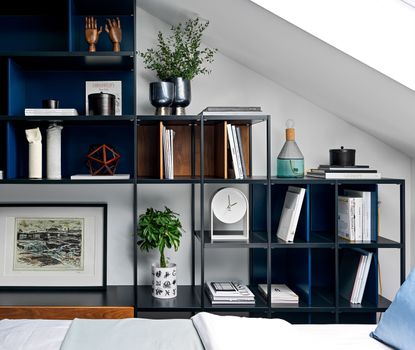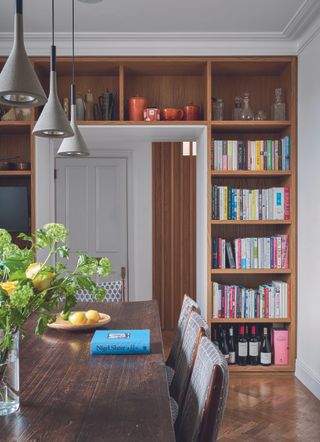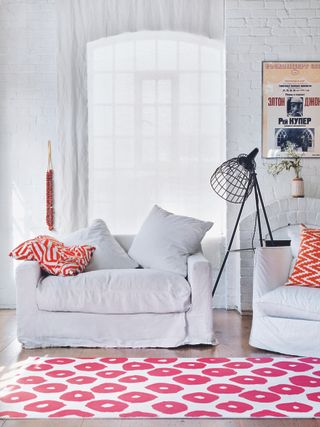These 3 moving tips will make packing and unpacking your home so much easier, say professional movers
These professional packers share their moving in tips to make your move less stressful


No matter how many disagreements arise in the process, there's one thing that everyone can agree on: moving is stressful. There are endless possessions to sort through, inevitable breakages, and despite the stacks of boxes you bought in preparation, you always seem to be short. (Not to mention the back strain.)
If you've ever tried to pack up your entire life and transport it in multiple car trips, you'll understand the struggle. Whether it's your dream modern home, or just home for now, moving into a new house or apartment really isn't easy if you don't hire professional movers to help you, that is.
Although we all want to save money where we can, using a moving company really is worth the investment. Since we all take pride in our homes, moving our furniture and the other items that go in them should be treated with just as much care.
Not only will hiring professionals make your move a lot smoother, but they also know a thing or two about how to pack your and transport your belongings efficiently. Before you begin your move, save yourself some stress with these moving in tips from UK-based removal company, Abels, and you'll have more time for the best part, decorating your home.

Lilith is an expert at following news and trends across the world of interior design. She's committed to helping readers make the best choices in their homes through writing practical tips and guides to help inform their design choices. For this piece she spoke with leading moving companies to understand all there is to know about moving home.
1. Organize your boxes
Once you've made your moving house checklist, it's time to start packing. Although larger furniture items can be awkward and heavy, packing smaller items is probably the most time consuming (and tedious) part of a move. How many times have you found your reams of bubble wrap have become bulky, only to arrive at your new place to find your beloved crockery cracked at the bottom of the kitchen box?
Fitting everything into boxes can feel like a game of Tetris, but luckily Abels have a few tips for packing your boxes yourself in a more organized fashion. 'Ensure that each box is fully packed, with heavier items on the bottom and lighter ones on top,' says Kavan McCullagh, director of sales at Abels.
Use larger boxes for kitchenware items, such as pots and pans, and smaller boxes for more decorative pieces like photo frames and ornaments. While it might seem obvious, you should keep designated boxes for separate rooms, too, making sure you mark them on the top. This way you can unpack every room methodically.
2. Pack items you use less frequently first
Moving home isn't the kind of job that's done in half a day. Packing is a lengthy process and you'll need to take regular breaks, so don't pack essential items until the last minute. Leave out glasses, plates and cooking utensils so you can still whip up a meal if need be, and make sure your phone charger isn't packed in the bottom of a box with your other electricals.
'We suggest that you start with the items you use the least,' explains Kavan. 'Books can be relatively easy items to start packing, just remember to pack them carefully to protect their spines and to use a relatively small box, as lots of books can be very heavy to lift!' This will make it lots easier when it comes to decorating bookshelves in your new home, too.

It's a good idea to pack a suitcase with several changes of clothes, toiletries and other essentials so you have important items at hand once you move in. This way, you don't have to rush to unpack all your things.
Movers also often offer bespoke packing options to make life easier. 'We often move clients that have opted to pack only a portion of the contents, leaving our team of experts to pack the remaining items,' Kavan notes. 'A popular choice would be our ‘Fragile Pack only' option which includes your glass and china.'
To ensure safe transportation, removal vans often have to load the vehicle to balance the weight meaning your belongings won't necessarily be unloaded in room-by-room order. But, with a trained team such as Abels, the movers will ensure all your boxes are placed in the correct room. 'We can even arrange to have your beds made for your exciting first night in your new home,' Kavan adds.
3. Set up the kitchen and bedrooms first
Once all of your belongings have been unloaded into your new home, you're now faced with the mammoth task of unpacking. Knowing where to start can be overwhelming. You should think logically about which rooms you'll need to use first, focussing on functional spaces like bedrooms, kitchens and bathrooms.
According to Kavan, it's a good idea to set up your bedroom furniture first. 'Quite often you are moving into your new home late in the day, so ensuring you have a comfortable night’s rest is important,' he says. 'We also ensure that essentials for the kitchen are unpacked, so that you can enjoy a cup of tea or glass of champagne to celebrate your move!'
If you have children or pets, Kavan also recommends setting up a designated space as soon as you move in. 'A dedicated room for cats and dogs can be crucial to ensure that your pets' transition into the new home is as stress-free as possible,' he explains. 'For younger children, a priority space would be their bedroom or playroom to ensure they're occupied and feel safe during the delivery process.'
It's also a good idea to give your new kitchen and bathroom a good clean before you start to unpack. 'These rooms are the highest "touch" areas of the house and they’re the ones you’ll want to use immediately,' explains a spokesperson from cleaning brand, Method.
'Start by sanitising your fridge, as you’ll want to store any perishable foods as soon as possible,' they continue. 'Next, remember the high-before-low rule, cleaning high fixtures before moving on to appliances – making sure to move them away from the wall where possible to clean under and behind them, before finally moving on to counter-tops, drawers and lower cabinets.'

Moving tips for renters
If you're renting, moving in can pose other challenges. Nobody wants to cause damage to a home during a move, but the risk is greater for renters.
'Ensuring any shared entrances, corridors and stairwells are adequately protected is a must, as you do not want to mark any walls carrying furniture or boxes to your rental,' says Kavan. 'Also, if it is an high-rise apartment you are renting, getting access to the lift key for the relocation company to use will make your move quicker.'
When renting short term for a stop gap in the purchase process, Kavan suggests that it might be more economical to opt for part of your belongings to be stored with the mover. 'We often find our clients don't always require all of their furniture for a short-term rental agreement, therefore meaning that some belongings could remain safely within storage.'

How to make a home your own in a furnished rental
For some of us, moving doesn't involve transporting many personal belongings. If you're moving into a furnished place, decorating a rental to your own taste isn't always easy, but there are a few simple changes you can make without risking your deposit.
'In some instances, decorating your new home may be more about covering the things you don’t like rather the highlighting the things you do,' says Matthew Currington, technical director at The Lighting Superstore.
'For bigger projects in your new home, be sure to check with your landlord if they’re happy for you to tackle these on your own. Projects like laying vinyl floor tiles or using vinyl tiles on a kitchen backsplash are great options because they can be easily removed without creating damage to the existing tiles,' he explains.
If you're looking for advice on how to live with a sofa you don't love in a rental apartment, draping an unsightly sofa with a throw or blanket can allow you to customize a room to your own style and help build a color scheme. Introducing your own soft furnishings is a good idea too, and you won't need to run it by a landlord either.
'Bringing items like rugs, throw cushions, curtains and bedding into the space can instantly make it feel cozier,' says Matthew. 'When picking out a rug to decorate your new space with, remember bigger is better. Rugs can be a pricey investment, but these can be moved from home to home, making them more practical in the long run. As a bonus, they can also help hide ugly carpets.'
Be The First To Know
The Livingetc newsletter is your shortcut to the now and the next in home design. Subscribe today to receive a stunning free 200-page book of the best homes from around the world.

Lilith Hudson is the News Editor at Livingetc, and an expert at decoding trends and reporting on them as they happen. Writing news, features, and explainers for our digital platform, she's the go-to person for all the latest micro-trends, interior hacks, and color inspiration you need in your home. Lilith discovered a love for lifestyle journalism during her BA in English and Philosophy at the University of Nottingham where she spent more time writing for her student magazine than she did studying. After graduating, she decided to take things a step further and now holds an MA in Magazine Journalism from City, University of London, with previous experience at the Saturday Times Magazine, Evening Standard, DJ Mag, and The Simple Things Magazine. At weekends you'll find her renovating a tiny one-up, one-down annex next to her Dad's holiday cottage in the Derbyshire dales where she applies all the latest design ideas she's picked up through the week.
-
 This Genius Home Buy Takes Even the Most Cluttered Closet or Pantry From Drab to Fab in Seconds
This Genius Home Buy Takes Even the Most Cluttered Closet or Pantry From Drab to Fab in SecondsSay goodbye to wire racks and visual clutter — this home buy might seem like a splurge, but it will solve one of your biggest aesthetic problems.
By Brigid Kennedy Published
-
 8 of the Most Stylish Accent Chairs I saw at Milan Design Week 2024
8 of the Most Stylish Accent Chairs I saw at Milan Design Week 2024State of the art accent chairs were presented at this year’s Salone del Mobile and they were all about comfort, color, sculptural shapes, and interesting details
By Pip Rich Published